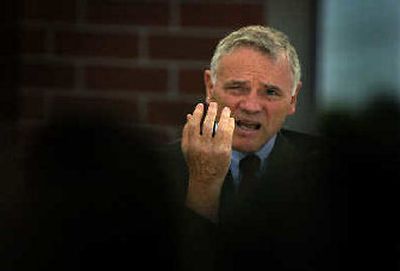Research institute gets big boost

A fledgling research institute that wants to help treat and eventually predict cancer, diabetes, cardiovascular diseases and other ailments has captured the formal support of a Seattle organization conducting high-profile biology research.
A partnership between Spokane’s and the Seattle organization, and the announcement on Tuesday of Washington Gov. Chris Gregoire’s formal support for the project, brings the Spokane effort a step closer to its goal of conducting world-class medical research on the Riverpoint Higher Education campus.Project supporters hope future molecule-level research by the institute will cure and eventually predict who is at risk for some of today’s most common diseases, including multiple sclerosis. The Eastern Washington and North Idaho region is second in the world in terms of the recorded rates of multiple sclerosis, according to the National Multiple Sclerosis Society. Spokane County has 1,100 people registered with the disease, according to the society.
Supporters also hope the project will help pump up Spokane’s economy by providing research that local companies could market, creating high-paying jobs. By 2010, the institute itself hopes to hire several hundred employees earning an average of $77,000 annually, according to an ISM press release.
The partnership with the Seattle-based Institute for Systems Biology and Gregoire’s support for the project were announced by during a ceremony Tuesday morning at the Sirti technology center. That building on the eastern end of downtown Spokane will house the institute for at least the next two years and will be renamed for the organization.
“It’s a great example of the innovative spirit we find throughout the state but particularly here in Spokane,” Gregoire said in her remarks. “This is a vision. It will not bear fruit tomorrow. But trust me, the world is watching Spokane, Wash.”The ISM, an effort of universities, hospitals, local business people and politicians, has been backed for several years by internationally known scientist Dr. Leroy Hood, who has helped spur donations to the project. Hood is one of the world’s leading scientists in the field of molecular biotechnology and genomics.
Now, his Institute for Systems Biology’s partnership with ISM will allow the ISM to train researchers in Seattle, share in patents from their research and raise funds together, he said.
Hood said he hopes his institute will be able to export its research findings to the ISM and the ISM, along with the companies that form around it, will move the knowledge from the laboratory to the health clinic or hospital. Both institutes use the systems approach, examining how all parts of the body work together instead of looking only at affected areas when determining cures and treatments. Researchers will go to the molecular level, studying genes and how the outside environment can disrupt them to cause disease.
“We’ll be able to pioneer new approaches to creating drugs, and eventually they’ll be the drugs that not just cure disease but will actually prevent disease,” Hood said.
Hood said he’d like to see ISM focus on diabetes and cardiovascular disease, two of the most common conditions, because that could help attract interest from the community.
The ISM has so far raised more than $3 million from universities, hospitals and several levels of government. It recently signed a two-year lease to move into about 6,000 square feet of space in Sirti’s technology center, making ISM the building’s largest tenant, said John Overby, a director of client services for Sirti.
In several years the ISM hopes to construct its own research facility on the WSU Spokane campus, ISM Chief Operating Officer Lewis Rumpler said. Rumpler said the ISM plans to formally launch in July 2007.
Rumpler said finding a scientist to direct the center is a crucial step. Hood said the ISM needs to have funding to pay a director for at least five years before it can expect any candidates to consider filling the position.
ISM also has far to go in funding before it can pull in the $30 million annual budget that organizers have planned for the institute.
But, Rumpler said, money from Spokane County, the state, WSU, Gonzaga University, Empire Health Services and Providence Health Care show that those organizations are committed to the project.
“It’s not just people saying ‘look, it’s a good idea.’ They’re saying ‘look, it’s a good idea and we’re willing to invest some money in it,” Rumpler said. “These folks all have money in the game.”